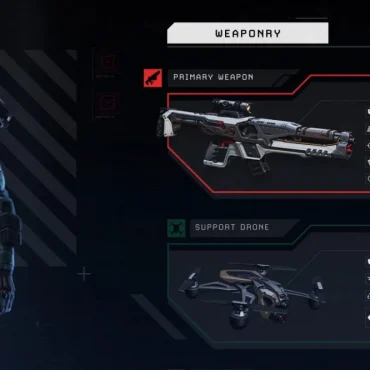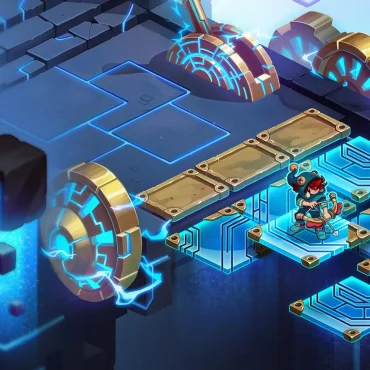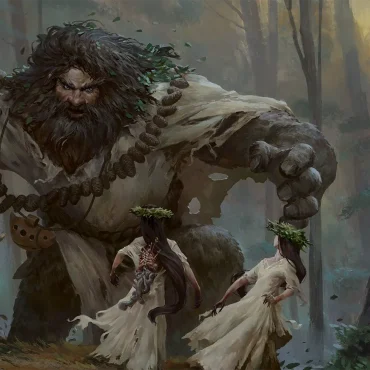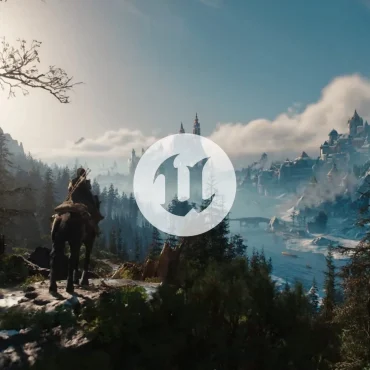Not long ago — okay, 2010-ish was really long ago — many developers operated on a “release-and-forget” mindset, shipping a boxed product and moving on. Today’s players see things differently.
In a recent survey we conducted on our LinkedIn, 50% of gamers chose a one-and-done full release as their ideal post-launch experience, compared to 22% preferring regular content updates and 28% favoring occasional major DLCs.
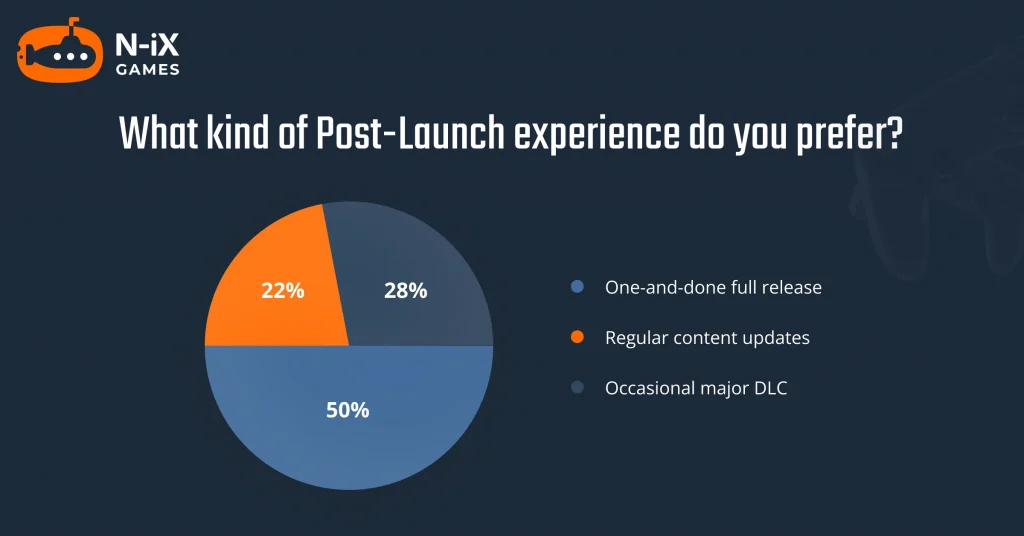
But even though a majority of players say they prefer a one-and-done, complete release, they still expect developers to keep supporting it in one way or another. Bugs and balance issues inevitably emerge once a game hits thousands or millions of players, and gamers expect studios to address these promptly. They also appreciate quality-of-life improvements, new features, and communication about the game’s future. Feedback is no longer a post-launch afterthought — it’s part of development DNA, and players expect and reward transparency and responsiveness. This expectation holds true even for single-player titles. In short, a “complete” game isn’t assumed to be perfectly final anymore; gamers trust that any rough edges will be smoothed out in the weeks and months after release.
It’s worth noting that developers themselves acknowledge this new normal. Most studios still plan to ship games as premium products (a 2024 survey found 76% of developers were aiming for an upfront full game release on their next project). However, they recognize that supporting the game post-launch is crucial for player satisfaction and a game’s long-term reputation.
In the following sections, we’ll look at a range of post-launch game support approaches — from minimalist to ongoing — and how each benefits the players, the game, and the developers.
Full release and post-launch patching
Sometimes a game doesn’t need a flood of new content to succeed; it just needs to deliver a polished experience and be kept in good shape. The classic “one-and-done” model — a full, self-contained release — is still a winning formula for many genres and studios. Single-player adventures, story-driven RPGs, or tightly designed indie games often follow this approach.
However, even these games require post-release patching and fine-tuning. The sheer variability of player behavior and hardware configurations means that no matter how thorough the QA game testing, launch day will reveal bugs, balance issues, or optimization gaps that need fixing. Addressing these swiftly shows the player base that the developers are listening and committed to quality.
A great recent example is Baldur’s Gate 3. This RPG launched as a complete, content-rich game, yet Larian Studios rolled out several hotfixes and patches in the first weeks to squash glitches and even added new epilogue scenes based on fan feedback. The first major patch alone fixed over 1,000 issues and even introduced a new “farewell” ending sequence to give players more closure.
Another example — Elden Ring — a huge single-player adventure that became a massive hit at launch but still saw balance adjustments and performance improvements via patches in the months after release. In cases like these, post-launch game support is less about adding content and more about ensuring the game lives up to its full potential for everyone who bought it.
Even smaller fixes and communication count. Whether it’s a day-one patch to address last-minute bugs or community managers acknowledging known issues on forums, players appreciate when developers neutralize critical bugs quickly via hotfixes and keep the dialogue open. This attentiveness builds trust. Gamers remember studios that stand by their product. On the flip side, if a game-breaking bug is left unaddressed or feedback is ignored, a one-off release can quickly lose goodwill.
One-and-done doesn’t literally mean “done” at launch — it means no planned new content, but dedicated upkeep is expected.
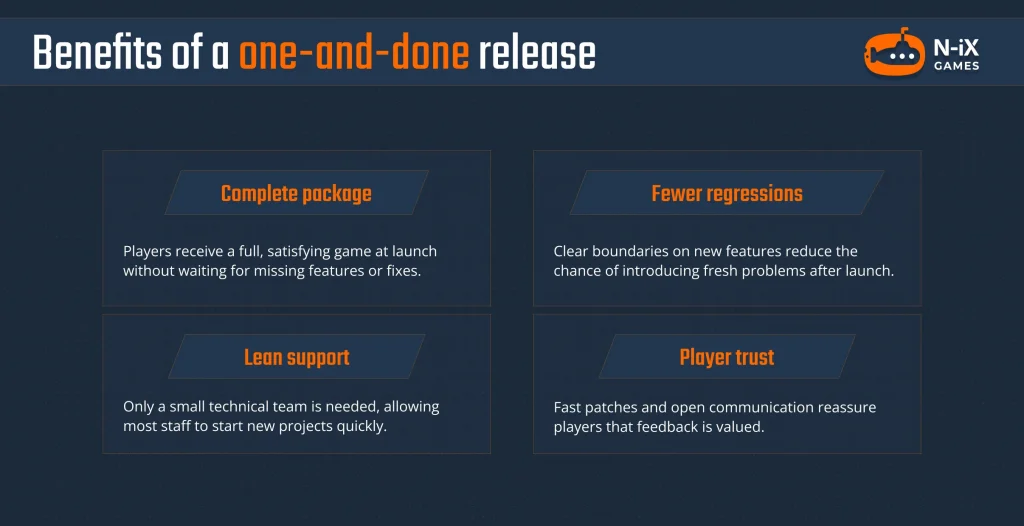
New platform releases
An effective post-launch strategy is to extend a game’s reach to new platforms after the initial release. Not every studio can launch simultaneously on PC, consoles, mobile, Samsung smart fridge — often it’s pragmatic to ship on one primary platform first, then port the game elsewhere later. These staggered platform launches can become a form of post-launch support in themselves, serving as a second wind for the game’s community. When done right, bringing a game to a new platform re-engages existing fans and introduces whole new audiences to the title, effectively giving the game a sales and playerbase boost without creating an entirely new product.
In recent years, we’ve seen numerous examples of this approach paying off. Many formerly console-exclusive games found new success on PC: Horizon Zero Dawn was released on PC in 2020, three years after its PlayStation debut, and sold over 3.3 million copies on Steam by 2023 — a tremendous second life for the title. Similarly, 2018’s God of War hit PC in 2022 and moved roughly 2.5 million units to new PC players by the end of 2023. Likewise, Fall Guys (2020) originally on PC/PS4 later launched on Xbox, Switch and went free-to-play in 2022 — sparking a surge of new players and returning ones, essentially reviving interest in the game.
New platform updates often coincide with improvements or content updates too. For example, when Ghost of Tsushima released a Director’s Cut on PS5 (a year after the PS4 launch), it bundled in an expansion and technical enhancements, giving fans a reason to revisit the game on new hardware. Even simply optimizing an existing game for next-gen consoles or releasing a “Complete Edition” is a good post-launch support that reinvigorates community discussion and attracts late adopters.
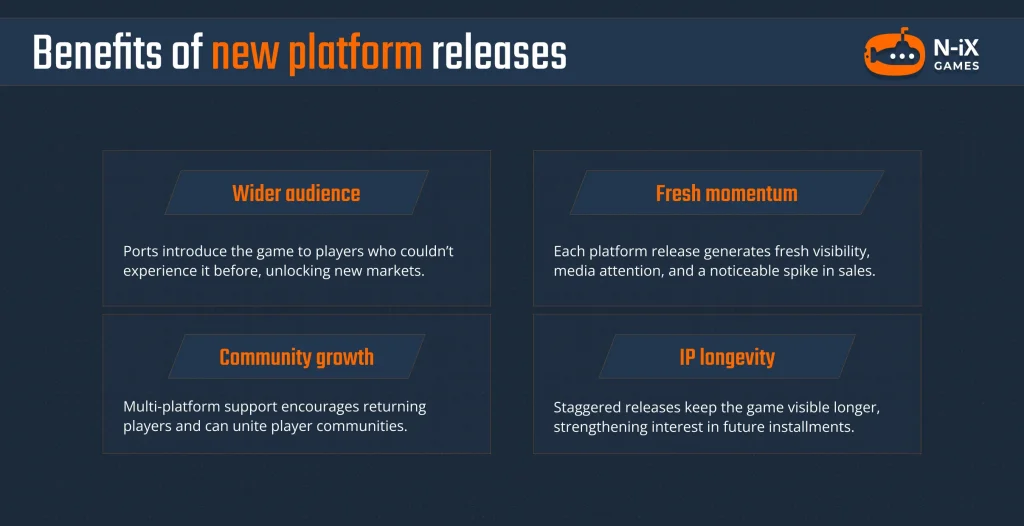
DLC and major post-launch updates
Often, ideas that didn’t make it into the initial release (due to time or budget constraints) can be developed later as DLC. In other cases, an expansion is planned from the start — a way to continue the game’s story or gameplay loop while part of the team moves on to concept the next title. For players, DLCs are a chance to spend more time in a world they love; for developers, they’re an opportunity to keep the game fresh and generate additional revenue without creating a brand-new game from scratch.
Recent years have seen successful examples across genres. Cyberpunk 2077 launched in late 2020 to a rough start, but CD Projekt RED spent years improving the base game and finally released the Phantom Liberty expansion in 2023. That DLC was essentially a massive add-on adventure, and it revitalized the player base — upon Phantom Liberty’s launch, Cyberpunk’s concurrent players on Steam surged to over 230,000, a level not seen since the game’s initial release. Another example: Ghost of Tsushima (2020) introduced the Iki Island story expansion in 2021, letting fans who had finished the main game dive back into a new chapter of Jin’s journey.
DLC not only satisfies existing fans’ craving for more content, but also draws attention from newcomers once the game is re-marketed in its expanded form. For instance, when Dead Cells got DLC updates, roughly 30% of the monthly players during those release months were brand new to the game. There is also a goodwill aspect: delivering a substantial DLC (especially if some updates are free) shows that the team is invested in the game’s world and its fans. Players feel that their initial purchase has extra value because the experience keeps growing.

Mod game support
One of the most powerful (and often underrated) ways to support a game post-launch is to open it up to the players themselves through mod game support. Games like Skyrim or GTA V are still played fervently in 2025, largely thanks to user-generated mods that keep the experience continually new.
From the developer perspective, supporting mods requires some upfront investment (exposing modding APIs, documentation, perhaps moderation), but it can pay back enormously by boosting the game’s longevity and community loyalty.
A healthy mod scene can keep sales going for years as new players come in, attracted by what the community has to offer. Potential players might see YouTubers play bizarre mods (yes, Thomas the Tank Engine dragon mod, I’m looking at you!), and it persuades them to buy the game and join the fun.
Giving players mod tools is like instantly hiring hundreds of additional “volunteer developers” who will keep creating content for your game. Mods can inspire future official content — studios sometimes hire talented modders or incorporate the most popular mods into updates.
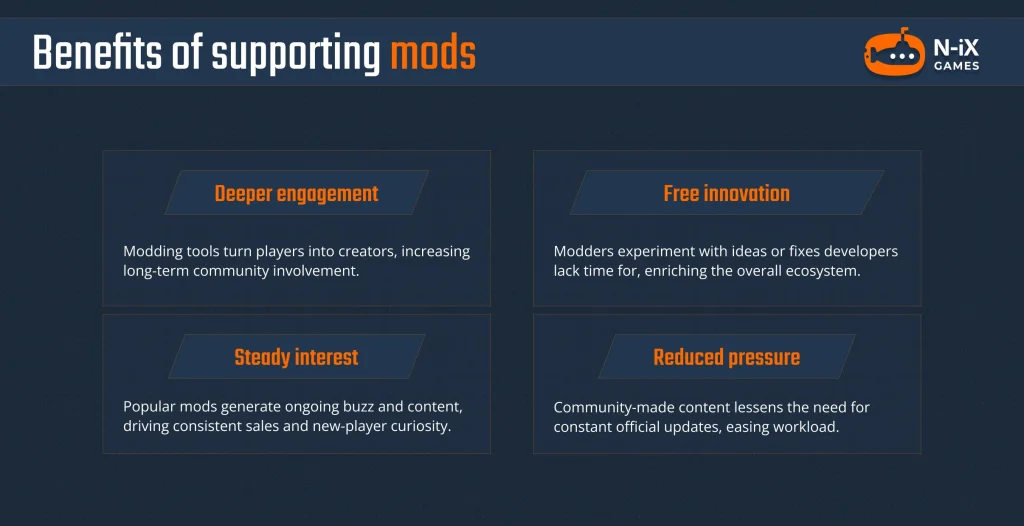
Regular content updates
Finally, we should touch on the approach that often comes to mind first: the full live service model of continuous updates. These are the type of games that aren’t intended to “end” at all — instead, they receive a steady stream of new content, events, and improvements over a span of years. We won’t dive too deep here (this topic deserves an article of its own), but it’s important to acknowledge that ongoing content game support is a major trend in modern gaming.
From multiplayer shooters like recent Ark Raiders to MMORPGs to even some single-player titles, many games today launch with a roadmap of additional content drops: seasonal events, new characters or items, fresh story chapters, time-limited challenges, and so on. This approach aims to keep players continuously engaged and often monetizes via microtransactions or battle passes to fund the ongoing development. The model has proven immensely successful for certain games and audiences.
For developers, the live service approach offers ongoing revenue opportunities and the chance to build a long-term community (rather than starting from zero with each new title). It also allows a game to evolve with player preferences — the team can introduce content that data and feedback show players want, almost like a running conversation.
However, it’s a massive commitment. Studios need dedicated live ops teams, robust infrastructure for frequent updates, and strategies to combat content fatigue. Not every game is suited to this, and the industry has seen its share of live service attempts that faltered due to lack of content or players losing interest. There’s a reason many live games have shut down in recent years if they couldn’t maintain engagement. So this approach is high-risk, high-reward.
That said, when done well for the right game, regular content updates can yield incredible loyalty. The key is to identify an audience that craves ongoing engagement and to pace the updates so that players neither burn out nor get bored. Communication is again crucial here — live service games thrive on transparency, roadmaps, and community collaboration.
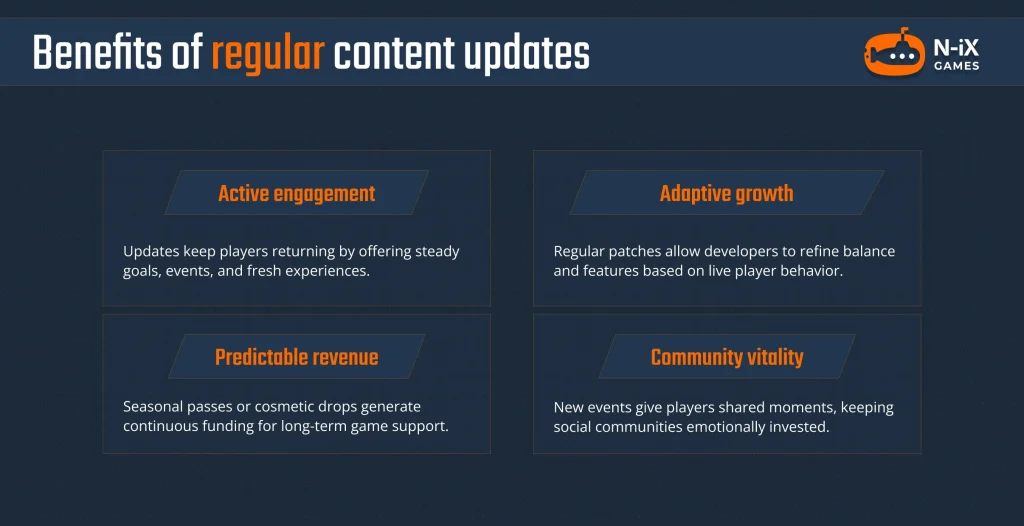
Wrapping up
No matter which form it takes, post-launch game support comes down to caring for the product and its players. It’s clear that in 2025, few gamers are content with a “fire-and-forget” release. They don’t necessarily need every game to become a never-ending service, but they do expect developers to stand by their work — to fix what’s broken, refine what can be better, and sometimes to expand the world they fell in love with.
This game support mindset is mutually rewarding. Players get more value and enjoyment, knowing their voices are heard. Developers build trust, community goodwill, and often see increased success (whether through sales of DLC, higher player retention, or enhanced reputation) as a result of that continued care. In the end, post-launch game support isn’t just a strategy for monetization — it’s a commitment to quality and community. And as many studios have learned, when you treat a game as an ongoing relationship rather than a one-off transaction, everyone benefits in the long run.
Post-launch game support with N-iX Games
N-iX Games offers flexible post-launch support for studios looking to maintain, improve, or expand their games after release. Our team brings over a decade of experience across engineering, art, QA, console development, and porting, and we’re comfortable integrating directly into existing workflows to match each project’s needs. With long-term co-development experience and collaborations with Supermassive Games, Paradox Interactive, Netflix, and Blizzard, we provide dependable, scalable support that helps games stay stable, updated, and welcoming to new players. If you’re exploring options for post-launch support, feel free to reach out — we’re always happy to discuss what your game might need next.

